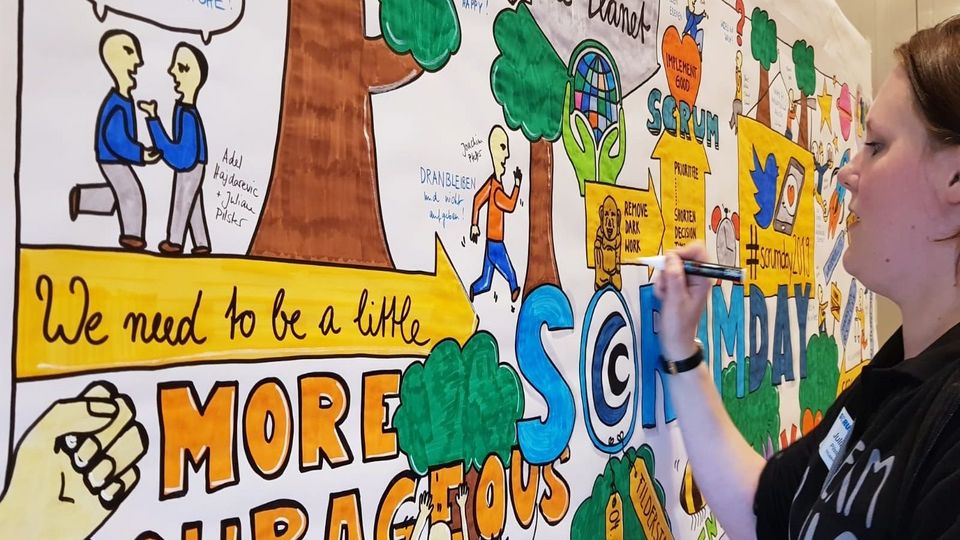Picture this: You’re sitting in a meeting, at your fingertips those old-school staples, a pen and a notepad, or if you’re more digitally inclined, a laptop. To capture everything being said, you listen attentively and write everything down – while sharing your thoughts from time to time. Nobody ever said meetings would be easy.
When the meeting adjourns, you’re left with piles of paper that you – in all sincerity – will probably never look at again. Your scribbled notes are unlikely to win any penmanship awards – there’s no time for calligraphy with so much multitasking to do – so they clutter up your desk until your next clean-up, when the desktop mess goes straight into the bin.
Armed with a pen, charm and nifty artworks, Juliane Pilster shows her TRUMPF colleagues that there is another way. She doesn’t take notes at meetings; she doodles. Her ‘sketch notes’ not only save paper, they also etch their way into her mind. “When I draw what’s spoken, I find it easier to understand correlations and remember. It’s how I summarize content, distill things down to the essentials, and connect images. This way, I can capture the atmosphere alongside the facts.” These visuals change the way we think and inspire the imagination.
You don't have to be good at painting for sketching, knows Juliane Pilster from TRUMPF.
It’s all in the name
Sketch notes are exactly what the name suggests – visual notes. These graphical renderings incorporate pictures, structural objects and even a few words here and there. Perhaps the earliest adopters were the Paleolithic artists that left their mark on caves. User experience designers – the people who develop apps and GUIs – hauled visual note-taking from the Stone Age into the digital age to draw, sketch and diagram their ideas. It’s said that Twitter was brainstormed with sketch notes.
You can draw on whatever you like – flipcharts, postcards, or the obvious choice, a notepad. Pencils or ballpoint pens work fine, but markers add a colorful flourish. Pictures help visualize discussed topics in more vivid ways. And our artwork is more interesting than a semi-illegible scrawl, so we’re more inclined to go over our meeting notes.
Well drawn is half retained
Sketches come with another benefit. Images stick better in our minds, so you may not have to consult your picturesque notes as often to jog your memory about key information. So, why is sketching a better memory-jogger? We can look to the cognitive school of multimedia learning for answers. Its dual coding theory postulates that people remember information better when they hear and see it.

You don't have to be good at drawing for sketching, knows Juliane Pilster from TRUMPF.
© TRUMPF
Don’t worry about drawing skills
If you’re afraid of drawing like a ham-fisted toddler, don’t be. It doesn’t take Picasso-like skills to learn how to sketch notes. “I studied industrial engineering in the field of electrical engineering. And my mother says since my earliest childhood that I can't paint.,” says Juliane Pilster. It may be seem counterintuitive, but drawing really is a technical skill for her. “Where do I place the eyes, ears and mouth when I’m drawing a face? There are clear principles at work here that everyone can learn.” And as lovely as some of these artworks may be, sketch notes are not primarily art; they’re a tool to assist your brain.
Crayons and coloring fun can be useful even to a high-tech company like TRUMPF. Sketch notes are an excellent medium for portraying prototypes of new machines, fleshing out concepts for research projects, and rendering new ideas in visuals that are easy to grasp at a glance. “This is particularly helpful in transformational processes,” says Juliane Pilster, an agile software development manager at TRUMPF. She is responsible for creating a working environment in which the teams can work independently and undisturbed. “A picture doesn’t use complicated technical terms. Everyone can ‘read’ and understand it.”





